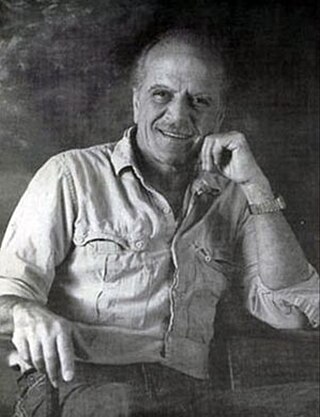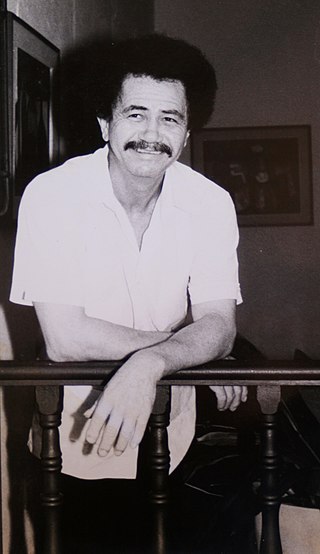Related Research Articles

Yucef Merhi is a Venezuelan artist, poet and computer programmer based in New York.

Rodolfo Abularach was a Guatemalan painter and printmaker of Palestinian descent.

Rita Ackermann is a Hungarian-American artist. She lives and works in New York City.

Regina José Galindo is a Guatemalan performance artist who specializes in body art. She was born in Guatemala City.
Margarita Azurdia, who also worked under the pseudonyms Margot Fanjul, Margarita Rita Rica Dinamita, and Anastasia Margarita, was a feminist Guatemalan sculptor, painter, poet, and performance artist.

Minerva Cuevas is a Mexican conceptual artist known for site-specific interventions guided by social and political research and social change ideals. Her production includes installation, video works and photographic works as well as contextual interventions in specific locations. She lives and works in the neighborhood of el Centro Histórico in Mexico City, often directing her artistic and social efforts towards questioning the capitalist system. She is a member of Irational.org and the founder of the Mejor Vida Corp. (1998) and International Understanding Foundation (2016).

Belkis Ayón was a Cuban printmaker who specialized in the technique of collography. Ayón created large, highly detailed allegorical collagraphs based on Abakuá, a secret, all-male Afro-Cuban society. Her work is often in black and white, consisting of ghost-white figures with oblong heads and empty, almond-shaped eyes, set against dark, patterned backgrounds.
Sofia Maldonado is a Puerto Rican contemporary artist. She lives and works between New York City and Puerto Rico. Maldonado has collaborated with the Nuyorican Movement.

Félix Rodríguez Báez, was a Puerto Rican painter, artist, graphic designer, set designer, cartoonist and art teacher.
Deborah Cullen is an American art curator with a specialization in Latin American and Caribbean art.
Sandra Monterroso is a Guatemalan visual artist and designer. Art historian Virginia Pérez-Ratton writes about Monterroso's beginnings as a performance artist in Guatemala during 1999 and 2000. Alongside her were other Guatemalan female performers like Regina José Galindo, Maria Adela Díaz, and Jessica Lagunas. Recently Monterroso's work focuses not only in performance art, she works with different media as videoart, installations and mix media. Her work is related to power structures, gender issues and decolonial thinking. Her work is included in the Artist Pension Trust.

Alicia Framis is a contemporary artist living and working in Amsterdam, Netherlands. She develops platforms for creative social interaction, often through interdisciplinary collaboration with other artists and specialists across various fields. Her work is project based and focuses on different aspects of human existence within contemporary urban society. Framis often starts out from actual social dilemmas to develop novel settings and proposed solutions. Framis studied with the French minimalist artist Daniel Buren and the American conceptual artist Dan Graham and her work can be located within the lineages of relational aesthetics, performance art, and social practice art. She represented the Netherlands in the Dutch Pavilion at the 50th Venice Biennale (2003). She is currently the director of an MA program at the Sandberg Instituut in Amsterdam, Netherlands and a lecturer at Nebrija University in Madrid, Spain. In 2019, Alicia Framis was awarded with the Lucas Artists Visual Arts Fellowship 2019-2022 in California.
Beatriz Santiago Muñoz is an artist based in San Juan, Puerto Rico. Her work combines aspects of ethnography and theater to create film and video projects that have touched on subjects including anarchist communities, the relationship between artwork and work, and post-military land. Her work has been exhibited at the Tate Modern, the Whitney Biennial 2017, Galería Kurimanzutto, and the Guggenheim Museum. She is co-founder of Beta-Local, an art organization and experimental education program in San Juan, Puerto Rico.
Anaida Hernández is a Puerto Rican sculptor, painter, installation artist, muralist, documentary director, and businesswoman. She was an active member of the Association of Women Artists of Puerto Rico and is considered as being a pioneer in addressing violence against women via contemporary Caribbean and Latin American art.
Cecilia Paredes is a Peruvian-born multimedia artist residing in Philadelphia. Her primary themes include the power of nature, femininity, and migration, which have been subjects of many of her shows. She frequently utilizes natural elements, often recycled waste materials and primarily organic ones, in her installations. One of her best-known works is "Paisajes" in which she camouflages herself and uses her own figure as a canvas for body painting.

Priscilla Monge is a Costa Rican artist. She is one of the best-known female artists from Central America.

Priscila De Carvalho is a Brazilian-born American contemporary artist who is known for paintings, sculptures, murals, site-specific art installations, and permanent public art.
Teresa Serrano (1936) is a Mexican painter, sculptor, and filmmaker. She gained recognition through her work in filmmaking in the mid to late 1990s. Her main focus has been "to make forceful commentaries on power relationships, sexism, and violence against women".
Pia Camil is a Mexican contemporary artist. Camil works in painting, sculpture, installation and performance.
Carolina Caycedo is a multimedia artist based in Los Angeles.
References
- ↑ "Jessica lagunas". Elizabeth A. Sackler Center for Feminist Art. Brooklyn Museum. Retrieved 31 March 2016.
- ↑ "Kickass Woman of the Day: Artist Jessica Lagunas Embroiders With Her Grey Hair". The Frisky. 9 September 2013. Retrieved 31 March 2016.
- ↑ "Jessica Lagunas". Show Studio. Retrieved 31 March 2016.
- ↑ Wren, Celia (28 June 2014). "Diaspora: 'Flow' at IDB Cultural Center; Kazakh music at the Kennedy Center". The Washington Post. Retrieved 31 March 2016.
- ↑ "Para Verte Mejor / The Better to See You With". Jessica Lagunas Art Portfolio. Archived from the original on 15 March 2016. Retrieved 31 March 2016.
- ↑ Aponte 2011, p. 21.
- ↑ "| jessica lagunas |". www.jessicalagunas.com. Retrieved 12 April 2022.
- ↑ "| jessica lagunas |". www.jessicalagunas.com. Retrieved 12 April 2022.
- ↑ Aponte 2011, p. 20.
- ↑ Quiñones, Emilia (2012). "The Red Veil: Wedding Dresses Against Gender Based Violence in Latin American Art" (PDF). Saitabi: 168. Retrieved 31 March 2016.
- ↑ "In Memoriam". Jessica Lagunaas Art Portfolio. Archived from the original on 6 October 2008. Retrieved 31 March 2016.
- ↑ Aponte 2011, p. 21-22.
Sources
- Aponte, Solmerina (2011). "Cultural Materialism and the Art of Latinas in New York: Creating a Revolutionary Visual Arts Discourse on Ethnicity, Women's Rights, Exile and the Latino/a Diaspora" (PDF). Camino Real. 3 (5): 11–36. Archived from the original (PDF) on 13 May 2016. Retrieved 31 March 2016.
- Pérez-Ratton, Virginia (2008). "Performance and Action Work in Central America 1960-2000: A Political and Aesthetic Choice". In Deborah Cullen (ed.). Arte =/= Vida. New York: El Museo Del Barrio. pp. 204–213.